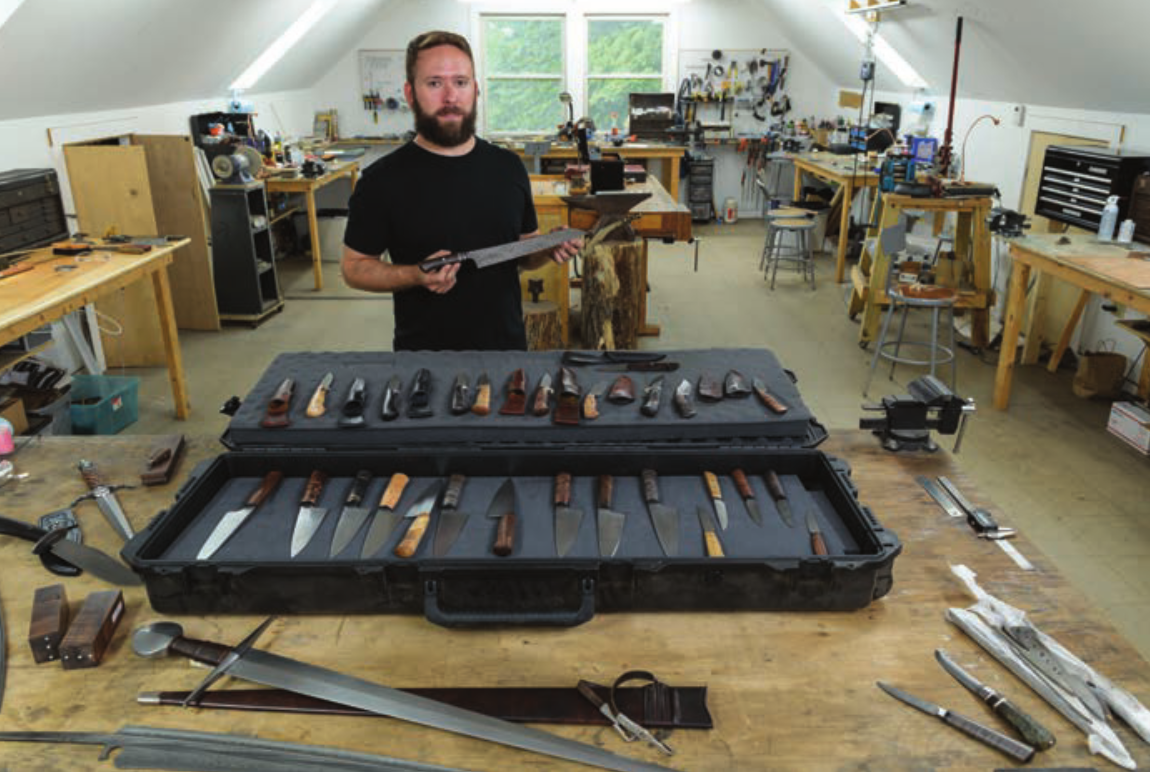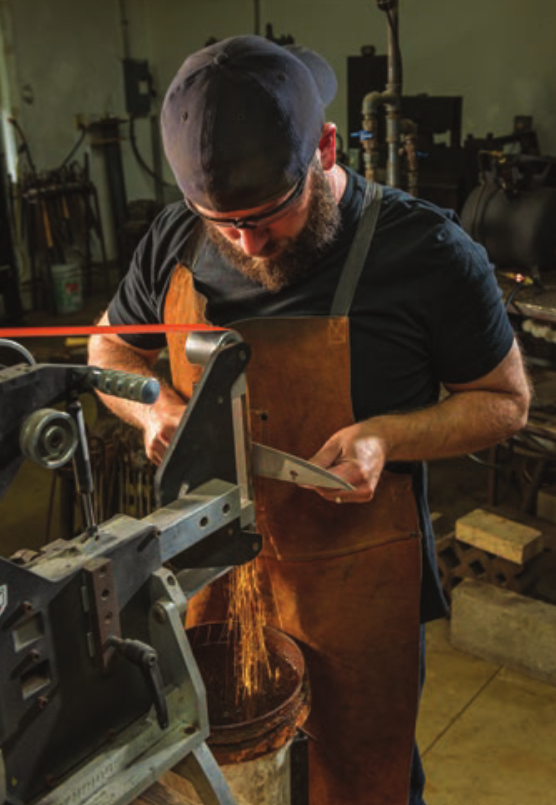Creating Beauty With Heat, Steel and Force

Zack Jonas elevates tools to unique works of art.
When Zack Jonas was ten years old, he took his mother’s paring knife and hid it under a sofa in the basement.
There was a fascination that drew him to the knife. He never cut anything with it or used it—he simply took it out and admired it from time to time. It held a powerful allure that led him to seek out instruction, increase his skill and eventually embark on a unique, creatively fulfilling vocation.
Now, Jonas has achieved the rank of Master Bladesmith—a rare designation bestowed by the American Bladesmith Society. There are only 121 such craftsmen at that rank in the world.
“I view the ranking of Master Bladesmith as a starting point,” Jonas says from his workshop in Wilmot. “I figure I’m young, and there’s plenty of time to learn—and that’s the goal.”
Master Bladesmith Zack Jonas at his shop in Wilmot
It’s the path of lifelong learning that led the New Hampshire resident to work toward perfecting his craft. Jonas spends his days at the forge and anvil, hydraulic press and power hammer, using heat, steel and force to create stunning works. His Damascus steel blades shimmer with an almost incandescent beauty. From chef’s knives with maple, sycamore and oak handles, to steak knives, to opulent, decorative pieces, Jonas’ high-carbon steel blades are stylized, yet useful.
It’s not an easy craft, but the results are remarkable and utterly unique.
“It can be tedious, dangerous and painful,” Jonas says. “But I love it anyway.”
New Hampshire Home [NHH]: How did you find your way to bladesmithing?
Zack Jonas [ZJ]: I
have loved knives since I was kid, and around the early aughts—just as
Google was hitting its stride—I found a custom knife-making website.
That’s when it dawned on me that people were making them, and I wanted
to try it. I opened my mouth enough times, found a connection, then
found a class at the Massachusetts College of Art in Boston. I started
in 2006. I was unenrolled at the time, attending on a continuing
education basis a couple of evenings a week. I took the same class
back-to-back eight times. It got me access to a fully equipped metal
studio with no overhead cost. It had a whole shop, all the consumables,
the steel and, of course, the expertise of Master Bladesmith J.D. Smith
as the instructor.
NHH: How did you learn the craft?
ZJ: I actually never experienced anything at MassArt outside of the metal studio.
Jonas’
work includes culinary, field and decorative knives. From top left,
clockwise: a seven-inch chef’s knife; an eight-inch nakiri; a seven-inch
chef’s knife and a ten-inch quillon dagger with a grip made from
35,000-year-old swamp kauri.
It
was this basement industrial space, but that’s where I learned all the
fundamentals of my craft under J.D.’s guidance. At that time, he had
students who had gone on to become professional knife makers, which for
him was unusual. Most of his students were there to try something
interesting, not necessarily to make knives but [to learn] how to
make a knife, if you understand the distinction. [The class] was not
super detail oriented, but a few of us dug in and got a lot more out of
it because we wanted to.
NHH: Tell us about your workshop—the place where these blades are created.
ZJ: My
workshop is in Wilmot. It’s pretty spacious at about 2,500 square feet,
and I’ve got all kinds of gear in there: several anvils, multiple
forges, a power hammer, a hydraulic press, machine tools. There are at
least three things in there that weigh more than a ton. New England is a
great place for [finding the right tools] because there are a lot of
smiths working here. The anvil I use most of the time is from the barn
of our real estate agent’s brother. [Tools like this] are around. Some
of it is modern, but a lot is old as well. One of my anvils is a
three-hundred-pound turn-of-thecentury English anvil. I also have a
World War II–era band saw. I have a couple of machines from the ’60s.
NHH: What’s the most rewarding moment in the process for you?
ZJ: There
are two. My work falls into two buckets: one is production, even though
all my blades are handmade, and the other is higher-end collector
oriented. Production is faster and simpler, and [those knives are] very
clearly made to be used every day. Higherend collector stuff has the
same performance standards, but I may spend more time in finishing. For
the production side, people come up to me at shows and tell me, “I
bought a chef’s knife from you two years ago, and I smile every time I
cut something.” With collectors, it’s more direct feedback. I may make a
fancy dagger that someone will never use, hopefully, but it will be
more fulfilling on a creative level.
NHH: Is there one blade you’ve created that you feel best defines what you’ve been working toward?
ZJ: It
was actually one set of five pieces. In 2019, in June, I earned the
rank of Master Bladesmith through the American Bladesmith Society. The
second of two tests was to present a set of five knives that expressed
the very finest of my artistic ability. I started the first knife in
2017, and I finished the last one right before June 2019. It took me 2½
years to do it. It wasn’t to the exclusion of anything else, but I
worked on them quite a lot. They range from a small, little knife— based
on a knife from Finland called a puuko—and up to a fancy
European-style dagger that was the centerpiece of the set. The dagger is
the one knife in the set that was required to be something specific—it
had to be that style of dagger with certain features to it.
Much fine detail work goes into bladesmithing.
NHH: There are intricate, waving designs in some of your work. What are those?
ZJ: That’s
Damascus steel. The simplest explanation is that it’s two different
alloys of steel fused together at high temperatures, and then folded or
bent or twisted or carved to reveal the layers in different patterns.
You can do random designs, but most of it is very carefully
choreographed. The pattern is the direct result of each step you take in
the forging process. Some steps can be very bold and visible from a
great distance, while some are extremely fine and intricate and almost
holographic in how they reflect light. The best way to conceive of that
is compare a bar code to a cross walk. You can see one from one hundred
yards away, and the other, you have to get pretty close to make out the
detail.
NHH: Can you talk about the balance of art and function in your work?
ZJ: I
don’t necessarily have a strong opinion that form follows function. If
you’re making a knife to perform a certain task, the ergonomics have to
work out. But I don’t draw a distinction [that one outranks the other].
It ought to be beautiful and functional. People come to me and say,
“Hey, I have this idea, this oddball idea ...” Sometimes I love that
because they may come up with something I’ve never thought of. A couple
of years ago, I was asked to combine a classic American Bowie knife with
an Arabian or Yemeni dagger called a Jambiya.
It’s
something I never would’ve thought of in a thousand years. I loved
it—it was a great project. More frequently, though, someone will come to
me about this oddball thing, and I’ll have to say, “I’m sorry, that’s
not the work that I do.”

Jonas' work covers wide ground—from chef's and field knives to swords and decorative pieces.
NHH: How does something like a chef’s knife come into existence?
ZJ: With
Damascus steel, a chef’s knife starts as a bundle of 1 /16-inch strips
or bars of metal. I tack them together with a welder at a high
temperature and then fold them. Those strips become a single bar of
steel, and from there, the process is identical to anything
non-Damascus. I cut off the material I need, I heat and hammer the bar
until it’s exactly the shape I want. A forging session, which is about
10 percent of the work, for one knife would be about twenty to sixty
minutes. There are big outliers on that, though. Right now, I’m working
on a sword that’s extremely complicated. It’s multiple bars of Damascus
steel folded together. I spent three to four days on the forge just
shaping that.
NHH: What are some of the risks associated with your work?
ZJ: My
nephew asked me when he was five if I ever burn or cut myself. I said,
“Yes, every day.” He looked at me agog, because to a five-year-old,
that’s crazy. What I explained is that a baker gets flour on himself. I
get cut and burned— it’s just part of the job. Most of the time, you
hope, it’s relatively minimal. But the fact of the matter is, a lot of
tools and processes I use in my craft can quickly or slowly kill you.
I’m very serious about the precautions I take and the way I approach my
work and various equipment.
NHH: Have you seen the reality TV show “Forged in Fire”?
ZJ: Yes,
I was on it. I did very badly— I went out hard in the first round. It
was through no fault but my own. I was given a piece of material I had
never used before, and there was a flaw in it that I failed to identify.
But it was a good experience, and I really enjoyed it. Truncated
timetable aside, it’s pretty representative of what we do.

Jonas at work in his shop.
NHH: What is it about bladesmithing that makes it so rewarding to you?
ZJ: There’s
something I’ve never been able to articulate about loving knives. I
don’t know what it is, but I’ve always found them compelling. A friend
of mine who is a Bladesmith put it this way: “You don’t make knives
because you like making knives, you make knives because you like having
made knives.” I get to make these awesome objects that look epic. It
drives you onward. Then there is, of course, the never-ending skill
progression. There’s always something you can do better, something new,
something you can add to your repertoire. NHH
RESOURCE
Zack Jonas • (603) 877-0128 • jonasblade.com